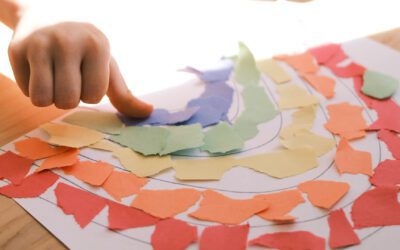Art Therapy in Miami
Art Therapy can help improve cognitive and sensory-motor functions, build and improve social skills and improve emotional self expression
What is Art Therapy?
Benefits of Art Therapy for Children
What Happens During an Art Therapy Session?
Schedule an Art Therapy Evaluation
Introduction to Art Therapy
Art therapy is a mental health profession which involves the use of art making and the creative process to help improve cognitive and sensory-motor functions, build and improve social skills, promote self-esteem and improve emotional expression and self awareness.
Childrens art therapy is often confused with play therapy. While a play therapist may use some play based activities in their sessions when suitable, Art Therapy focuses on using art media to help children visually express emotions and communicate through creative expression.
Art Therapy allows children to communicate their thoughts and ideas visually and without using words. This makes it particularly helpful for treatment of children with varying mental health problems and language development issues.
Always Keep Progressing offers Art Therapy in Miami with our board certified art therapists offer a range of art therapy services and art therapy sessions from our clinic.
When might art therapy be prescribed?
At Always Keep Progressing an art therapist may prescribe art therapy as a standalone therapy or, supporting another therapy such as speech therapy. Art therapists work with children to improve communication skills and self expression through during art therapy sessions.
Art Therapy can used “in” other traditional therapy as a way to enhance therapeutic techniques.
ArtTherapy can also used “as” the therapy where the art forms the mode of expression and processing.
Art Therapy can be beneficial for children who are:
- Struggling with emotional expression
- Struggling to communicate
- Suffering low self esteem
- Having difficulty self regulating
- Struggling with socialization/social skills
- Experiencing difficulty with sensory integration (over or under stimulated)
- With Autism
- Experiencing Anxiety
- With ADHD
- Communication difficulties
What happens during an Art Therapy session?
An art therapist will base the session on the childs needs, developmental level and goals and educational requirements. But can be broken into Structured Sessions, and Less Structured Sessions or Directive and Less Directive.
Directives are what we use as “activities” or “instructions” in an art therapy session. Art therapy directives serve as a way to explore or work on a particular goal that a client has in session. An art therapist often offers a directive as a way to help client express themselves through creating art and the art-making process allowing their artistic expression be the primary source of communication.
While the techniques and materials may look very similar, the structure changes depending on the needs of the child.
Structured session are often used for children that struggle following directions, boundaries, communication.
-
The therapist will have art material, creative activity and a directive selected prior to the session for your child to engage with upon arriving at the session.
-
Your child will engage with the art supplies and the art project to create art, as the therapist offers support, through verbal cues or “third hand”.
Third-hand: an art therapists way to show empathy, attunement and manual support for the child during their art-making process. For ex: if a child is demonstrating frustration or a lack of coping skills with a clay sculpture that is falling over, a therapist may assist them by holding up the figure.
-
After the session, your child and the art therapist will then work together to clean up the art materials, such as colored pencils, coloring books, or paints.
Less structured session are primarily used for children who are more independent, require more emotional expression, are more verbal and looking for increased social skills
- The therapist and child will select materials together if they are more independent.
- The therapist will often allow for your child to lead the session with regards to the art made.
- The therapist will offer support and encouragement to clients throughout the session.
- The therapist will approach your child with curiosity to discuss feelings, the art and build a relationship.
- Your child and therapist will discuss the session at the end while picking up the art materials.
Benefits of Art Therapy for children
Art therapy is a form of psychotherapy that uses artistic expression and the creative process to help children and adolescents cope with emotional, behavioral, and mental health challenges. It can be an effective treatment for a wide range of issues, including anxiety, depression, trauma, and social difficulties.
Art Therapy provides a safe space where children can express emotions, trauma, or negative feelings. It has a huge range of benefits including:
Some benefits of art therapy for children include:
-
Improved emotional regulation: Art therapy can help children learn to express and manage their emotions in healthy ways. It can also provide a safe and non-threatening outlet for children to explore and express difficult feelings.
-
Increased self-esteem and self-awareness: Through the creative process, children can gain a sense of accomplishment and pride in their work, which can boost their self-esteem and self-worth. Art therapy can also help children gain insights into their thoughts, feelings, and behaviors, leading to increased self-awareness.
-
Enhanced social skills: Art therapy can help children develop social skills, such as communication, cooperation, and problem-solving. It can also provide a supportive and accepting environment for children to practice these skills and build relationships with peers.
-
Stress relief: The creative process can be a form of relaxation and stress relief for children, helping them cope with the challenges of daily life.
-
Improved academic performance: Art therapy can also have a positive impact on children’s academic performance. It can enhance focus, attention, and memory, as well as improve problem-solving and critical thinking skills.
Art therapy can be a valuable addition to a child’s treatment plan, and it can be incorporated into a range of settings, including schools, hospitals, and mental health clinics.
Related
Art Therapy Articles
10 Incredible Benefits of Art Therapy For Children
Introduction Art therapy is the use of art-making and the creative process to support the more traditional therapeutic process. Sessions are facilitated by a board certified, registered art therapist to address desired goals. Art therapy sessions will often...
Art Therapy: A Creative and Fulfilling Career Path
If you have a passion for art and a desire to help others, then art therapy may be the perfect career path for you. Art therapy is the use of art making and the creative process to help improve cognitive and sensory-motor functions, build and improve social skills,...
5 Easy Art Therapy Activities You Can Do At Home
What is art therapy? Art therapy is a mental health profession which involves the use of art making and the creative process to help improve cognitive and sensory-motor functions, build and improve social skills, promote self-esteem and improve emotional expression....
















